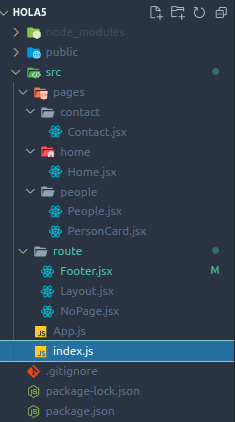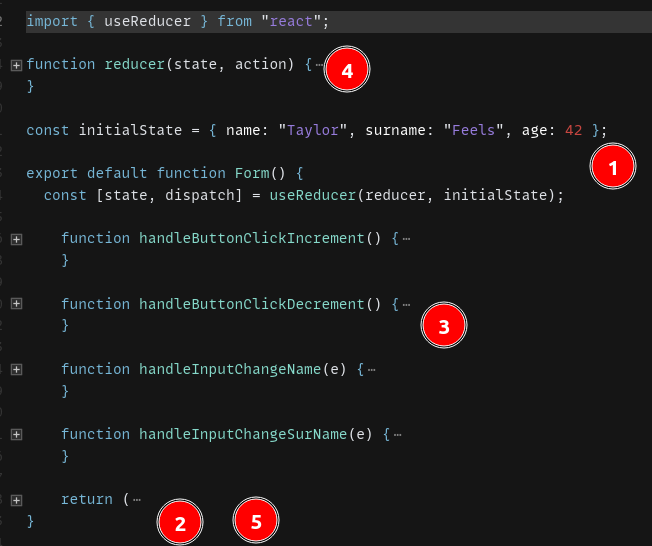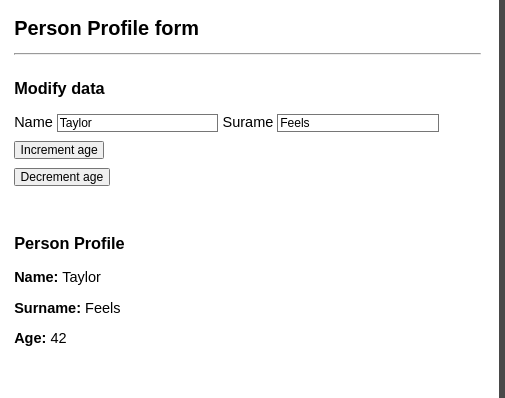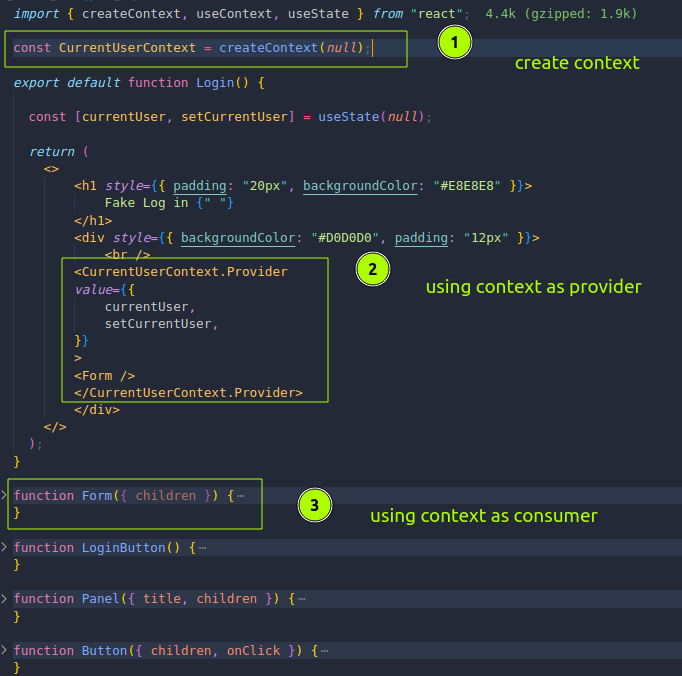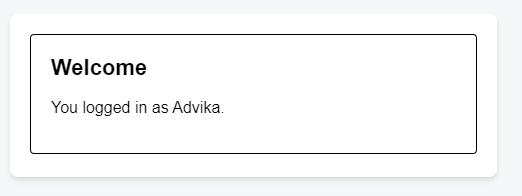Lab#RE02-1: Router & Hooks
ReactJS labs, Router & Hooks
📘 React JS Lab#RE02-1: Router & Hooks
In this lab, we will be using:
- the
react-router-dom, which is a package with bindings for using React Router in web applications. - We will use the
Axioslibrary to make HTTP requests to the API and retrieve the data in JSON format. - hooks:
useState,useEffect,useReducer.
The lab will demonstrate how to use a react-router-dom with React to build a functional web application.
Reference: codesandbox React Project to-do-11
1 Install react-router-dom
From: npm pacakge and react router
React Router enables “client side routing”.
In traditional websites, the browser requests a document from a web server, downloads and evaluates CSS and JavaScript assets, and renders the HTML sent from the server. When the user clicks a link, it starts the process all over again for a new page.
Client side routing allows your app to update the URL from a link click without making another request for another document from the server.
Instead, your app can immediately render some new UI and make data requests with fetch to update the page with new information.
A Single Page Application (SPA) is a web application that loads a single HTML page and dynamically updates the content as the user interacts with the application. The user interface is designed to provide a seamless experience, without the need for page refreshes.
In contrast, a Multi-Page Application (MPA) consists of multiple pages, each with its own HTML file, that are loaded separately when the user navigates to a different page. Each page typically has its own styles and scripts, which can result in longer load times and a less seamless user experience compared to SPAs.
2 Tree-folder & routes
We use React Router DOM library to create a web application with multiple pages.
The import statement at the top imports several components from the React Router DOMlibrary, including BrowserRouter, Routes, Route, and Link.
These components are used to define the routes and navigation for the application.
The
Layout,Home,People,Contact, andNoPagecomponents are defined in separate files and imported at the top of the code.
The App component is the main component of the application and is exported as the default component. This component returns JSX, which is a syntax extension to JavaScript used to describe how the user interface should look like.
The <BrowserRouter> component wraps the <Routes> component, indicating that this is the root of the application’s routing system.
Within the <Routes> component, there is a single <Route> component that has a path attribute set to “/”. This means that any URL that matches the root of the application will render this component.
The <Route> component with the path attribute set to “/” has four nested <Route> components inside it, each with a different path attribute and element attribute that points to the component that should be rendered when the corresponding URL is accessed.
- The first nested
<Route>component has an index attribute, which means it will be rendered when the root URL is accessed. This component renders the Home component. - The second nested
<Route>component has a path attribute set to “/people”, which means it will be rendered when the URL ends with “/people”. This component renders the People component. - The third nested
<Route>component has a path attribute set to “/contact”, which means it will be rendered when the URL ends with “/contact”. This component renders the Contact component. - The fourth and final nested
<Route>component has a path attribute set to “*” which means it will be rendered when none of the other routes are matched. This component renders the NoPage component, indicating that the page the user is looking for cannot be found.
Route:
import { BrowserRouter, Routes, Route } from "react-router-dom";
import Layout from "./route/Layout.jsx";
import Home from "./pages/home/Home.jsx";
import People from "./pages/people/People.jsx";
import Contact from "./pages/contact/Contact.jsx";
import NoPage from "./route/NoPage";
export default function App() {
return (
<BrowserRouter>
<Routes>
<Route path="/" element={<Layout />}>
<Route index element={<Home />} />
<Route path="people" element={<People />} />
<Route path="contact" element={<Contact />} />
<Route path="*" element={<NoPage />} />
</Route>
</Routes>
</BrowserRouter>
);
}Layout, in this particular case we stack all components:
import { Outlet, Link } from "react-router-dom";
import React from "react";
import Footer from "./Footer";
export default function Layout() {
return (
<>
<nav>
<Link to="/">Home</Link>
<span>|</span>
<Link to="/people">People</Link>
<span>|</span>
<Link to="/contact">Contact</Link>
<span>|</span>
</nav>
<Outlet />
<Footer />
</>
);
}3 useReducer person profile form
Reference:
- codesandbox with handlers functions
- codesandbox dispatcher onChange, onClick
- React reference manual: useReducer
3.1 Create route
To add a PersonForm or Form component to a new route:
- first import the
PersonFormcomponent. - Then, add a new Route element under the Layout Route element with a path of “person-form” and an element prop with the
PersonFormcomponent. - Finally, update the
Layoutcomponent to render a Link component to the new route.
3.2 reducer
This new feature on Hola5 defines a React component called “Form” that allows users to modify and display a person’s profile information. It uses the useReducer hook to manage the component’s state, which is initialized with an object that contains the person’s name, surname, and age.
The “reducer” function defines how state should be updated based on different types of actions dispatched by the component. The actions include incrementing or decrementing the person’s age and changing their name or surname.
The component’s state is initialized with an object (1)
The component renders a form with input fields for the person’s name and surname and buttons to increment or decrement their age. It also displays the current values of the person’s name, surname, and age.
When the user interacts with the form elements (5), the component dispatches (3) the appropriate action to the reducer function (4), which updates the state and causes the component to re-render with the updated values (5).
Reducer:
function reducer(state, action) {
switch (action.type) {
case "incremented_age": {
return {
name: state.name,
surname: state.surname,
age: state.age + 1
};
}
case "decremented_age": {
return {
name: state.name,
surname: state.initialsurname,
age: state.age - 1
};
}
case "changed_name": {
return {
name: action.nextName,
surname: state.surname,
age: state.age
};
}
case "changed_surname": {
return {
name: state.name,
surname: action.nextSurName,
age: state.age
};
}
default: {
throw Error("Unknown action: " + action.type);
}
}
}With or without handlers functions? Best without extra-functions but be careful with recursion, use arrow functions:
export default function Form() {
const [state, dispatch] = useReducer(reducer, initialState);
return (
<>
<h1> Person Profile form</h1>
<hr /><br />
<h3> Modify data</h3>
<label>Name</label>
<input
value={state.name}
onChange={(e) =>
dispatch({
type: "changed_name",
nextName: e.target.value
})
}
/>
<label>Surame</label>
<input
value={state.surname}
onChange={(e) =>
dispatch({
type: "changed_surname",
nextSurName: e.target.value
})
}
/>
<button onClick={() => dispatch({ type: "incremented_age" })}>
Increment age
</button>
<button onClick={() => dispatch({ type: "decremented_age" })}>
Decrement age
</button>
<br /> <br /> <br />
<h3>Person Profile</h3>
<p><strong>Name:</strong> {state.name}</p>
<p><strong>Surname:</strong> {state.surname}</p>
<p><strong>Age:</strong> {state.age}</p>
</>
);
}With handlers, perhaps a more verboise option:
export default function Form() {
const [state, dispatch] = useReducer(reducer, initialState);
function handleButtonClickIncrement() {
dispatch({ type: "incremented_age" });
}
function handleButtonClickDecrement() {
dispatch({ type: "decremented_age" });
}
function handleInputChangeName(e) {
dispatch({
type: "changed_name",
nextName: e.target.value
});
}
function handleInputChangeSurName(e) {
dispatch({
type: "changed_surname",
nextSurName: e.target.value
});
}
return (
<>
<h1> Person Profile form</h1>
<hr />
<br />
<h3> Modify data</h3>
<label>Name</label>{" "}
<input value={state.name}
onChange={handleInputChangeName} />
<label> Surame </label>
<input value={state.surname}
onChange={handleInputChangeSurName} />
<button onClick={handleButtonClickIncrement}>
Increment age</button>
<button onClick={handleButtonClickDecrement}>
Decrement age</button>
<br /> <br /> <br />
<h3>Person Profile</h3>
<p>
<strong>Name:</strong> {state.name}
</p>
<p>
<strong>Surname:</strong> {state.surname}
</p>
<p>
<strong>Age:</strong> {state.age}
</p>
</>
);
}4 useReducer, useEffect, useRef clock
Reference:
This component creates a simple stopwatch with three buttons: Start, Stop, and Reset.
The state of the stopwatch is managed using the useReducer hook, which takes in a reducer function and an initial state.
The reducer function is responsible for updating the state based on actions dispatched by the buttons.
function reducer(state, action) {
switch (action.type) {
case "start":
return { ...state, isRunning: true };
case "stop":
return { ...state, isRunning: false };
case "reset":
return { isRunning: false, time: 0 };
case "tick":
return { ...state, time: state.time + 1 };
default:
throw new Error();
}
}The spread operator ... allows you to expand an iterable object (like an array or an object) into individual elements or properties: here is used to copy all the properties of the state object and then override the isRunning property with the value true.
The initial state includes two properties, isRunning and time:
The useEffect hook is used to start and stop the stopwatch. When the isRunning state is true, a timer is started using setInterval that dispatches a tick action every second. When isRunning state is false, the timer is cleared using clearInterval.
useEffect(() => {
if (!state.isRunning) {
return;
}
idRef.current = setInterval(
() => dispatch({ type: "tick" }), 1000);
return () => {
clearInterval(idRef.current);
idRef.current = 0;
};
}, [state.isRunning]);setInterval: setInterval(code, delay)
clearInterval: clearInterval(intervalID)
The core business-logic of this code is the combination of:
the
useEffecthook (which synchronizes execution with two different sources) andthe render cycle
trigger-render-paint(due the change of state ofstate.timebysetIntervalandtick).
The key-idea of the useEffect in this particular use (related to a timer problem) is the synchronization of the execution with two different triggers:
timer: setIntervaland clearIntervalwith idRef
useEffect, first render: when the component is loaded.useEffect, with its dependencies:state.isRunning, when user clicks buttonstart,stoporreset.
The core business-logic is completed with the render-cycle. The key-idea here is when and who call the render-cycle:
- with the change of the state the component triggers the render cycle: every time clock is ticking, that is, every one second:
state.timebysetIntervalandtick.
The return statement returns a JSX template that displays the stopwatch: there are three buttons: “Start”, “Stop”, and “Reset” that dispatch start, stop, and reset actions respectively.
The idRef is a reference to the timer, and it is updated every time the useEffect hook is called.
The returned value of setInterval, which represents the ID of the interval, is stored in idRef.current.
The cleanup function of the useEffect hook allows us to stop side effects that no longer need to be executed before our component is unmounted.
When to use a cleanup function:
- Canceling a fetch request
- Cleaning up Timeouts
- Cleaning up Intervals
- Cleaning up Event Listeners
- Closing up Web Sockets
useEffect(() => {
// ...
return () => {
clearInterval(idRef.current);
idRef.current = 0;
};
}, [state.isRunning]);This cleanup function will be executed before the next effect execution or when the component unloads (unmounts). Inside the cleanup function:
- The
clearIntervalfunction is called with theidRef.currentvalue to clear the interval and stop the associated callback function from executing. idRef.currentis set to 0 to indicate that the interval has been cleared.
The cleanup return function ensures that any resources or side effects created by the effect are properly cleaned up and disposed of, preventing memory leaks or unintended behavior.
In this case, it ensures that the interval is cleared and any associated callbacks are stopped when the component unmounts or when the isRunning value changes to false.
5 api Rest
5.1 Axios
Install axios using npm:
Axiosis a promise-based HTTP Client for node.js and the browser.It is
isomorphicOn the server-side it uses the native
node.jshttp moduleOn the client (browser) it uses
XMLHttpRequests.
isomorphic: it can run in the browser and nodejs with the same codebase.
We use the Axios library to fetch data from the JSONPlaceholder API, which provides a fake REST API for testing and prototyping.
5.2 Component
The component initializes a state variable called data using the useState hook, and sets its initial value to an empty array.
The useEffect hook is used to fetch the data from the API and update the data state variable when:
- the component mounts or
- when the
setDatafunction is called.
The axios.get() method is called with the URL of the API endpoint:
The response is handled with a then block that sets the data state variable to the response data. If there is an error, it is logged to the console with a catch block.
In the component’s return statement, the fetched data is rendered using the .map() method to loop through each item in the data array.
The key prop is added to each item to help React identify the items and improve performance.
import React, { useEffect, useState } from "react";
import axios from "axios";
export default function AxiosApiRest() {
const url = "https://jsonplaceholder.typicode.com/todos";
const [data, setData] = useState([]);
useEffect(() => {
axios
.get(url)
.then((response) => {
setData(response.data);
})
.catch((error) => {
console.log(error);
});
}, [setData]);
return (
<>
<h1> My data todos from axios</h1>
{data &&
data.map((item) => {
return (
<spam key={item.id}>
id: {item.id}
<spam>userId: {item.userId} </spam>
<spam>title: {item.title} </spam>
<spam>completed: {item.completed} </spam>
<br />
</spam>
);
})}
</>
);
}6 useContext login
Reference: useContext hook: Example #1
createContext, useContext, useState working together
In this example, there is a currentUser state variable which holds an object.
We combine { currentUser, setCurrentUser } into a single object and pass it down through the context inside the value={}.
This lets any component below, such as LoginButton, read both currentUser and setCurrentUser, and then call setCurrentUser when needed.
App.js
import { createContext, useContext, useState } from 'react';
const CurrentUserContext = createContext(null);
export default function MyApp() {
const [currentUser, setCurrentUser] = useState(null);
return (
<CurrentUserContext.Provider
value={{
currentUser,
setCurrentUser
}}
>
<Form />
</CurrentUserContext.Provider>
);
}
function Form({ children }) {
return (
<Panel title="Welcome">
<LoginButton />
</Panel>
);
}
function LoginButton() {
const {
currentUser,
setCurrentUser
} = useContext(CurrentUserContext);
if (currentUser !== null) {
return <p>You logged in as {currentUser.name}.</p>;
}
return (
<Button onClick={() => {
setCurrentUser({ name: 'Advika' })
}}>Log in as Advika</Button>
);
}
function Panel({ title, children }) {
return (
<section className="panel">
<h1>{title}</h1>
{children}
</section>
)
}
function Button({ children, onClick }) {
return (
<button className="button" onClick={onClick}>
{children}
</button>
);
}7 Versions
| Code Version | Commit | Folder-Tree | Screeshoots |
|---|---|---|---|
| Hola5 0.0 | create project with route: hola5 0.0 | initial tree-folder | render home |
| Hola5 0.1 | useReducer: user Profile hola5 0.1 compoonent useReducer on codesandbox with handlers functions or codesandbox dispatcher onChange, onClick |
userReducer tree-folder | render user profile |
| Hola5 0.2 | useReducer, userRef, useEffect: clock hola5 0.2 component clock on codesandbox |
clock tree-folder | render clock |
| Hola5 0.3 | api Rest hola5 0.3 component api Rest codesandbox |
api Rest tree-folder | render api Rest |
| Hola5 0.4 | useContext: fake login hola5 0.4 | useContxt login tree-folder | render useContext login - render useContext loged |
